Introduction
3D printing technology has been extensively explored as an innovative additive manufacturing method in various industries, including the automotive, textile, and biomedical fields (Jiang et al., 2020). In the food industry, 3D printing enables the creation of numerous tailored food products with desired geometries, colors, textures, and customized nutrition (Le-Bail et al., 2020). 3D printing methodologies for food ingredients include extrusion-based, selective sintering, inkjet, and binding printing (Liu et al., 2017).
Currently, extrusion-based printing is the most commonly used method in the food sector, and a range of food ingredients, including chocolate (Hao et al., 2010), dough (Yang et al., 2018), cheese (Bareen et al., 2021), and vegetables (Pant et al., 2021) have proven their suitability for the printing process, either independently or in combination with additives. However, a significant need exists for developing various edible printable inks, including fibrous materials such as meat. Additionally, the post-processing feasibility after printing should be considered in the case of raw materials such as meat, which require further cooking.
Based on their printability, raw materials are divided into natively printable materials (e.g., cheese), nonnatively printable materials (e.g., meat), and alternative ingredients (e.g., insects; Sun et al., 2015). Some raw materials with printability are easily extruded through nozzles without additional flow enhancers and can maintain structural stability after deposition (Kim et al., 2017). However, nonnatively printable materials require modification of their rheological and physical properties to achieve smooth extrusion and the desired printability. Alternative ingredients such as proteins and fibers have emerged as novel sources of beneficial constituents. They can be incorporated into other edible printing inks and printed into customized foods with the desired shapes (Severini and Derossi, 2016).
In 3D printing, the rheological characteristics of inks significantly affect the printing process and results, thereby serving as a key preliminary evaluation of ink development (Cheng et al., 2022). During the extrusion-based printing process, ink undergoes a series of sequential steps, including a static state, flow, extrusion, recovery, and self-support. Generally, low-to-medium viscosity with shear-thinning behavior is preferred to ensure initial fluidity and smooth extrusion (Jiang et al., 2020). In the recovery stage, the ink should exhibit a rapid recovery of viscoelasticity. After deposition, sufficient mechanical strength and yield stress are required to maintain a 3D structure with a high shape fidelity (Cheng et al., 2022). Therefore, many researchers have sought ways to improve the rheological characteristics of food inks, which are closely related to the printing performance. For example, pretreatments of inks, such as microwave, ultrasonication, and ozone treatments, have positive effects on increasing the viscosity and self-supporting ability of printed samples (Fan et al., 2020; Xu et al., 2020a). More powerfully, the incorporation of appropriate additives, such as hydrocolloids, lipids, carbohydrates, and salts, is widely used in food 3D printing (Chen et al., 2022).
This review provides an overview of the latest progress in animal resource-based 3D printing. Animal resources are categorized into meat, insects, dairy products, and egg-based pastes. Each section focuses on the effects of ink composition, printing conditions, and postprocessing on the rheological properties and printability of animal resource-based inks. Table 1 provides the ink composition, printing conditions, and characteristics of animal resource-based 3D printing.
| Category | Additive materials | Printing condition | Effects of material properties on printing | Printing picture & reference | |
|---|---|---|---|---|---|
| Meat | Chicken | Chicken, refined wheat flour (RWF), dw | Raw ground chicken: RWF=1, 2, 3:1 Nozzle diameter: 0.82 and 1.22 mm Printing speed: 2,400 mm/min |
• The RWF allows the absorption of water that confers strength to the dough, stabilizing the 3D printing. • The formation of a gluten network of wheat improves the flexibility of the dough and results in continuous extrusion. |
 Adapted from Wilson et al. (2020) with permission of Springer Nature. |
| Chicken, NaCl (0%, 1%, 2%, 3%, and 4%) | NaCl: 2% Nozzle diameter: 1.2 mm Printing speed: 25 mm/s | • The addition of 1%–4% NaCl increased gel strength below 40°C, but above 55°C, the samples were not extruded owing to the heat-induced crosslinking of chicken proteins. • NaCl addition caused the dissolution of the salt-soluble myofibrillar protein in the meat, forming solid gel network structures. |
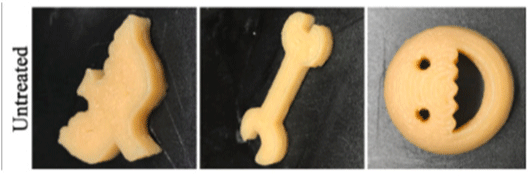 Adapted from Yang et al. (2022) with CC-BY. |
||
| Beef | Beef, hydrocolloid: xanthan gum (XG), guar gum (GG), k-carrageenan (KC), locust bean gum (LB)/ dw, NaCl (1%) | Mixing ratio: 0.5% and 1% hydrocolloid slurry Nozzle diameter: 1.2 mm Printing speed: 15 mm/s | • Hydrocolloid addition, except for certain conditions (1% KC and 0.5% KC/0.5% LB), allowed smooth extrusion, proving a significant decrease of viscosity at higher shear rates (shear-thinning behavior). • 1% KC and the control were not extrudable owing to severe shear-thinning properties and poor water-holding capacity. • The printed constructs with higher dimensional deviation exhibited increasing phase angles across frequencies, indicating less shape stability over time. |
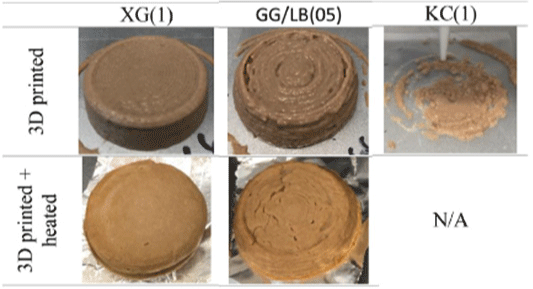 Adapted from Dick et al. (2021a) with CC-BY. |
|
| Pork | Pork, XG, GG, dw, NaCl | Mixing ratio: XG=1, GG=1, XG:GG=0.5:0.5, XG:GG=0.7:0.3, XG:GG=0.3:0.7 Nozzle diameter: 1.2 mm Printing speed: 20 mm/s | • Shear-thinning behavior was observed in all samples, including the control, but hydrocolloid addition showed higher viscosity than that of the control at a high shear rate due to improved intermolecular interactions. • The pastes containing hydrocolloids showed a less dense matrix with increased cavities resulting from improved water retention, affecting the texture (lower hardness, cohesiveness, and chewiness than the control). |
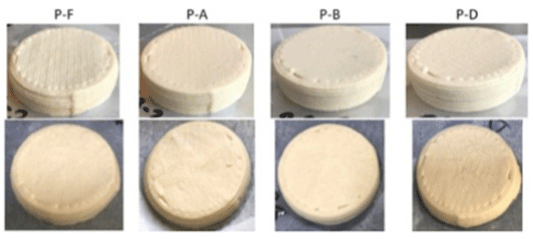 Adapted from Dick et al. (2020) with permission of Elsevier. |
|
| Edible insects | Yellow mealworm (YM) | YM, wheat flour (WF) | WF: YM=100:0, 90:10, 80:20 Nozzle diameter: 0.84 mm Printing speed: 30 mm/s | • The dough containing 0% and 10% YM was printed without significant difference from the designed structure, but the addition of 20% YM increased the diameter and decreased the height of the printed cylindrical snacks. • Increased insect content softens the dough and improves moisture evaporation during baking, which lowers the diameter reduction. |
 Adapted from Severini et al. (2018) with permission of Elsevier. |
| Mealworm | Mealworm protein isolate (MPI), chicken breast, potato starch | Chicken: MPI=MPI 0%, 10%, 30%, 50%, 70% Nozzle diameter: 1, 1.6 mm Printing speed: 30 mm/s | • The G’ value decreased as the MPI content increased owing to the low gel strength and reduced water-holding capacity of MPI. • The 30% and 50% of MPI gel exhibit a layer ripple owing to low gel strength. • When the MPI reaches 70%, structure formation fails owing to weak mechanical strength. |
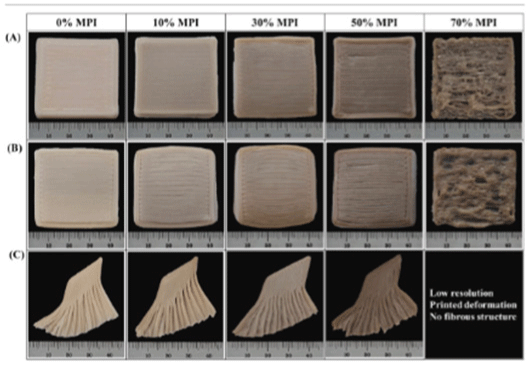 Adapted from Chao et al. (2022) with permission of Elsevier. |
|
| Cricket (Acheta domesticus) powder (IP=insect powder) | IP, soft WF | WF: IP=100:0, 75:25, 50:50, 25:75, 0:100 Nozzle diameter: 150 μm Printing speed: 5 mm/s | • 100% IP ink was difficult to print owing to its high viscosity, and 50% IP ink maintained a stable structure. • Increased IP concentration increased amino acid and water absorption capacity, and high insect content (50%–75%) and moderate solid content (40%–50%) showed optimal printing properties. |
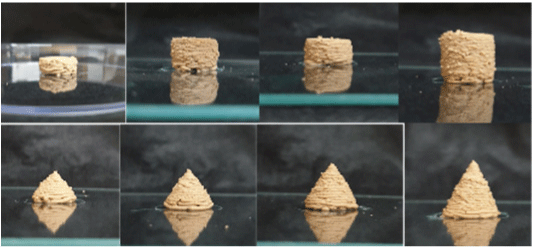 Adapted from Adedeji et al. (2022) with permission of John Wiley & Sons. |
|
| Dairy products | Yogurt | Greek yogurt, beef gelatin (Gel), whey protein isolate (WPI), citric acid, sweetener | WPI: Gel=0:7.5, 0:12.5, 6:10, 12:7.5, 12:12.5 Nozzle diameter: 1.5 mm Print speed: 2,500 mm/min | • The increased gelatin concentration increased the yield stress, storage modulus, loss modulus, firmness, and elasticity of the yogurt gel owing to enhanced gelatin gel network formation. • WPI could not form a cohesive network with the yogurt gel; therefore, it acted as an inert filler, weakening the yogurt gel network. However, the properties of WPI enable smooth gel extrusion in the 3D printing extrusion process, which reduces firmness and resilience and increases adhesion. |
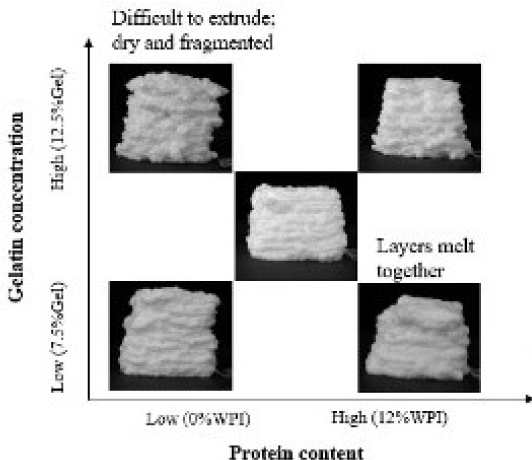 Adapted from Riantiningtyas et al. (2021) with CC-BY. |
| Milk powder | Heat-desiccated milk powder (HDMP), semi-skimmed milk powder (SSMP), cornflour (CF) | SSMP: HDMP=35:35, 40:20, 45:15, 50:10, 55:5 Nozzle diameter: 1.1 mm Print speed: 20 mm/s | • The formulation SSMP (55): HDMP (5.0) showed the highest dimensional stability and shape retention owing to the maximum yield stress and storage modulus. • According to the increase of HDMP, the lubricating effect occurs owing to the high-fat ratio (~33%) of HDMP to increase fluidity, whereas SSMP with a low-fat ratio is highly hydrophilic and improves self-supporting ability. |
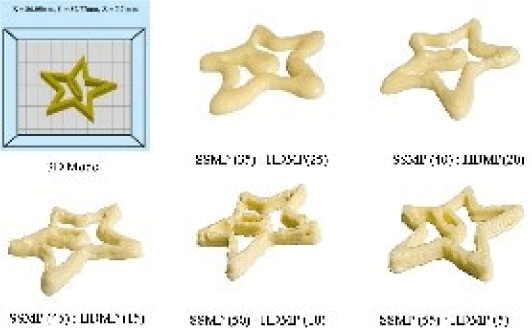 Adapted from Joshi et al. (2021) with permission of Elsevier. |
|
| Whey protein | Konjac flour (KF), curdlan, whey protein powder (WP), sodium bicarbonate | WP 5%, 10%, 15%, 20%, 25%, 30%, Nozzle diameter: 0.8 mm Print speed: 25 mm/s | • The sample with 20% whey protein can significantly improve printing performance, and the addition of whey protein powder impacts the 3D printing extrusion process and supportability of the printed product. • The addition of whey protein also improved the rheological properties such as storage modulus (G’), viscosity, and textural properties of the gel due to the destruction of the original starch gel structure and gradual formation of a new dense gel system. |
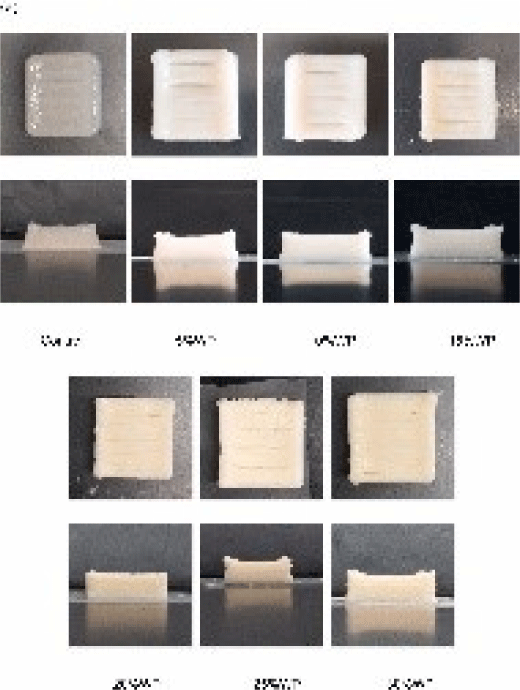 Adapted from Du et al. (2021) with permission of Elsevier. |
|
| α-Lactose monohydrate, WPI | Lactose:WPI=1:0, 3:2, 1:1, 2:3, 0:1, Nozzle diameter: 0.8 mm Print speed: 2 mm/s | • Blending with a lactose/WPI ratio of 1:1 exhibited the best printability, and it was an ideal printing material composition by maintaining the target geometry well after printing. • The rheological and mechanical properties of the lactose/WPI composite hydrocolloids and porous microstructure were changed based on the addition of lactose. Lactose-derived cosolvation retarded protein aggregation, improving printing performance and extrudability. |
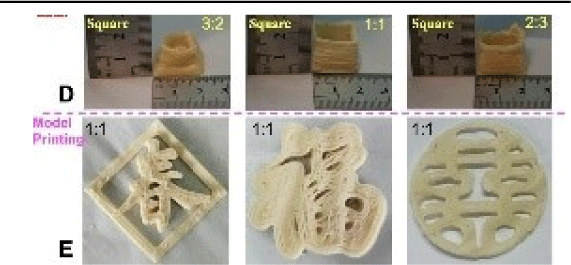 Adapted from Fan et al. (2022) with permission of Elsevier. |
||
| Egg products | Cheese | Heat acid coagulated milk (HACM) semi-solids, WPI, maltitol (MT), and citric acid | HACM semi-solids with WPI (2%–4%) and MT (2%–4%), total solid content of 48% (w/w) Nozzle diameter: 0.84 mm Print speed: 35 mm/s | • The formulation with WPI:MT=4:2 showed the best dimensional stability and shape retention, with relatively low firmness (<8N) but fairly high adhesion (~2 N s). • The addition of WPI above 2% significantly improved the recovery index, complex modulus (G*), and gel strength, whereas the addition of MT above 2% decreased the yield stress and recovery index. Excessive MT disrupts the casein network, forming a structurally unstable structure. |
 Adapted from Bareen et al. (2021) with permission of Elsevier. |
| Egg yolk (EY) / Egg white (EW) | Hen eggs, maltodextrin, rice flour | Egg powder (EY/EW): rice flour=1:1, 1:2 Nozzle diameter: 0.84 mm Print speed: 600 and 800 mm/min | • 3D printing with EY 1:2 material supply results in better binding capacity owing to complex interactions of protein fractions, resulting in better resolution, structural stability, and less deformation. • EY is stronger than EW owing to differences in function and binding properties of globular proteins of EW (ovalbumin) and EY (plasma and granule), respectively. |
 Adapted from Anukiruthika et al. (2020) with permission of Elsevier. |
|
| Egg white protein (EWP) | Egg albumen protein powder, edible bovine gelatin, cornstarch, and sucrose | EWP 0%, 1.0%, 3.0%, 5.0%, and 7.0% Nozzle diameter: 1.0 mm Print speed: 70 mm/s | • The 5% EWP mixture system improves the rheological, lubrication, and texture properties and the microstructure, making it ideal for 3D printing. • Excessive protein addition resulted in poor fluidity as reduced hydrophobic bonds in proteins eventually increased viscosity and promoted protein–protein interactions. |
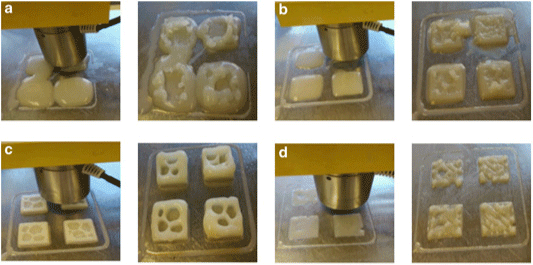 Adapted from Liu et al. (2019a) with permission of Springer Nature. |
|
Rheology of Edible Food Inks
Edible ink refers to food ingredient-based ink with appropriate printability. Extrusion is the first step in 3D printing. As the yield stress is related to the minimum stress required for the ink to flow, a low yield stress promotes flow initiation (Liu et al., 2019c). Viscosity is another key index of fluidity that indicates the resistance of ink to deformation under external stresses. Various factors such as ink composition, molecular weight, polymer concentration, temperature, and additives affect viscosity by altering inter-/intramolecular interactions (Yang et al., 2022). In general, 3D printing prefers inks with an appropriate viscosity within the extrusion force range of the printer. Moreover, the shear-thinning behavior is desirable for continuous extrusion. When the external shear rate increases during extrusion, shear dependence reduces the viscosity of the ink, leading to highly efficient printing (Dick et al., 2021b). Water-holding capacity also contributes to smooth and continuous extrusion. This affects the fluidity of the ink depending on the moisture content of edible food inks, which can move in a short period of time when passing through the nozzle. Dick et al. (2021a) reported that cooked beef pastes with a low water-holding capacity exhibited component separation under shear and, ultimately, nozzle clogging.
After leaving the nozzle, the ideal ink exhibits rapid shear-recovery behavior, forming stable and uniform filaments. The relevant rheological parameters were viscosity at rest, yield stress, and storage/loss modulus (G’ and G’’). Shear recovery behavior is often evaluated by subjecting the ink to changing shear rates to mimic the conditions before extrusion (low shear rate), extrusion (high shear rate), and the recovery state (low shear rate; Wang et al., 2021). A high recovery rate in viscosity or G’ ensures high structure maintainability. In addition, the stress during filament collapse is proportional to the yield stress; thus, the yield stress is associated with shape fidelity (Carvajal-Mena et al., 2022). In addition, the relationship between G’ and G’’ indicates the viscoelasticity and extent of frequency dependence (Cheng et al., 2022). Generally, for solid-like inks, G’ values must be higher than G’’ values over the frequency range, implying poor fluidity and shape stability (Liu et al., 2018). In addition, lower frequency dependence of G’ and G’’ is beneficial for highly stable and elastic structures (Liu et al., 2019b).
Therefore, rheology can offer insight into the structural properties and potential printing effectiveness of inks, and understanding their rheological properties before printing is essential.
Meat-Based Inks
Beef and poultry are the most popular and widely consumed food ingredients owing to their superior nutritional properties. 3D printing technology is a good option for using low-value by-products, such as inferior and tougher off-cuts and trimmings, and for producing customized and value-added meat products. Subsequently, several raw and cooked meat pastes were assessed as edible printing inks, which provided informative data regarding the desirable rheological properties and printing conditions of meat pastes.
Ground chicken (GC) was combined with refined wheat flour (RWF) at the ratios of 1:1, 2:1, and 3:1 (w/w; Wilson et al., 2020). The presence of RWF increased the water-holding capacity by improving the interaction between the amino acids in RWF and myofibrillar proteins in chicken meat. Regardless of the printing conditions, such as nozzle size and printing speed, the GC: RWF 1:1 ink did not extrude well owing to its high viscosity and hardness. GC: RWF 2:1 showed better printing performance in terms of extrusion and deposition compared to the formulation of GC: RWF 3:1. This is because as the ratio of GC increases, the hardness of the ink decreases, and the fluidity increases. The optimal conditions for printing GC: RWF 2:1 were a printing speed of 1,000 mm/min and an extrusion rate of 8.8 mm3/s using a 0.82-mm nozzle. The printed construct was subjected to hot air drying to manufacture chicken nuggets, followed by deep frying. The combination of both postprocessing methods helped maintain the 3D structure, and the nugget contained 92% of the crude protein and showed a 6.5% increase in fat content after postprocessing.
Another study reported the effects of complex factors such as NaCl addition, temperature, and nozzle diameter on the 3D printing accuracy of chicken breast-based ink (Yang et al., 2022). The addition of NaCl induced a decrease in viscosity at a low shear rate (0.1–0.3 s–1) and an increase at a high shear rate, facilitating the extrusion process. At all NaCl concentrations, the ink behaved more like a solid because NaCl caused the dissolution of the salt-soluble proteins in the meat, forming a gel network. G’ value of the samples containing 1%–4% NaCl increased below 40°C, but when the temperate was close to 55°C, all samples lost their fluidity with decreased G’ values. Furthermore, above 55°C, heat-induced crosslinking of chicken proteins occurred entirely, making it difficult to squeeze out through the nozzle. However, the effect of NaCl was restricted after the addition of >3%.
Additionally, as the nozzle diameter decreased from 2 to 1 mm, the strength of the printed constructs gradually increased. This is because the number of layers required for printing increased, resulting in a more compact structure. The best printing accuracy was observed under 1.3 mm nozzle diameter, 28°C nozzle temperature, and 2.5% NaCl addition. They also compared the cooking feasibility of 3D-printed constructs and mold-shaped products. The cooked printed samples showed similar textural characteristics to the mold-shaped samples, but nuclear magnetic resonance and scanning electron microscopy analyses demonstrated a more severe cooking loss in the printed samples due to the shear effect of 3D printing.
Using heat-resistant thickeners such as guar gum (GG) and xanthan gum (XG) improves extrudability and shape retention during the postprocessing of meat-based emulsion batters. For example, 0.5% GG was added to raw beef paste containing 1.5% NaCl for this purpose (Dick et al., 2019). They studied the effects of infill density (50%, 70%, and 100%) and fat (lard) content (0, 1, 2, and 3 layers within a structure) on the physical properties and textures of 3D printed products cooked by sous-vide method. While the infill density was proportional to chewiness, hardness, and moisture retention, it contributed inversely to shrinkage and cohesiveness. By contrast, increasing the fat layers in the constructs resulted in a higher cooking loss, shrinkage, cohesiveness, lower fat retention, chewiness, and hardness. Researchers have investigated the effects of different hydrocolloids on the rheological properties and printing performance of cooked beef paste (Dick et al., 2021a). Twelve beef-based pastes were prepared by adding 0.5% or 1% of cold-swelling (GG, XG) and heat-soluble (locust bean gum; LB, k-carrageenan; KC) hydrocolloids into minced beef blade roast cooked at 150°C in water for 5 h. Hydrocolloid addition, except for certain conditions (1% KC and 0.5% KC/0.5% LB), allowed smooth extrusion, proving a significant decrease of viscosity at higher shear rates (shear-thinning behavior). By contrast, the control cooked beef sample was not extrudable because of its poor water-holding capacity and lack of shear-thinning behavior. Another main finding was that the printed constructs with higher dimensional deviation (0.25% GG/0.25% LB addition) exhibited increasing phase angles across frequencies, indicating less shape stability over time. However, the pastes containing at least 0.5% XG or GG maintained the designed 3D shape even after heating (120°C for 15 min in a conventional oven), showing constant or decreased phase angles.
A pork product with a modified texture for patients with dysphagia has also been developed with hydrocolloid addition (Dick et al., 2020). Six pork-based pastes were prepared by adding 0.36% hydrocolloid slurry with different XG and GG proportions (1:0, 0.7:0.3, 0.5:0.5, 0.3:0.7, 0:1, and control; 0:0) into the mixture of ground cooked pork, water, and 1% NaCl. Shear-thinning behavior was observed in all samples, including the control, but hydrocolloid addition showed higher viscosity (3.48–3.98 Pa·s) than that of the control (1.84 Pa·s) at a high shear rate. The authors explained that the increase in viscosity resulted from intermolecular chain entanglement between the water molecules and hydrocolloids. In addition, regarding the printing performance, no significant difference was observed between the samples containing hydrocolloids, and the control samples showed the largest deviations in diameter and height. After post-processing (freezing at –18°C and heating at 100°C for 15 min), the pastes containing hydrocolloids showed a less dense matrix with increased cavities resulting from improved water retention, which also caused lower hardness, cohesiveness, and chewiness than the control paste. The developed 3D-printed pork products satisfied the requirements for texture-modified foods based on the results of texture analysis and International Dysphagia Diet Standardization Initiative (IDDSI) methods (Mulkern, 2020).
Edible Insect-Based Inks
Edible insect proteins, such as mealworms and crickets, are emerging as sustainable alternatives to protein resources owing to their similar protein content to animal proteins, fast growth rates, and high reproductive rates (van Huis, 2013). 3D printing technology was applied to create snacks from wheat flour (WF) dough fortified with ground yellow mealworm (YM) up to 20% as a source of proteins (Severini et al., 2018). The addition of YM softened the dough, which caused an increase in the diameter and a decrease in the height of the printed cylindrical snacks owing to the sagging of the stacked layers. This is because the water absorption capacity significantly decreased owing to either the presence of hydrophobic compounds in YM or reduced starch and gluten contents. Backing at 200°C for 22 min affected the structural dimensions. A reduction in the diameter of the printed constructs was observed regardless of the YM content. Interestingly, increasing insect enrichment resulted in softer dough and greater expansion upon water vaporization, which lowered the diameter reduction from 18.7 to 17.8 mm.
A mealworm protein isolate (MPI) was used as a softening agent to modify the texture of chicken surimi-based printing inks consisting of chicken breast meat and potato starch (Chao et al., 2022). The G’ value gradually decreased with increasing MPI concentrations from 0% to 70%, indicating the decreased viscoelastic properties of surimi inks. The incorporation of MPI significantly affected the printability and resolution of the printed constructs. The inks containing 0% and 10% MPI exhibited highly defined resolution with shape accuracy, whereas the inks with 30% and 50% MPI showed a layering ripple owing to lower gel strength. At 70% MPI concentration, the ink was challenging to extrude, resulting in unsuccessful filament formation. In addition, despite the low water-holding ability of MPI, the heating process of the printed constructs improved water retention because the coaxially printed potato starch layers effectively absorbed water inside the gel matrix. The hardness of the printed cooked surimi samples decreased with increasing MPI gel content. Soft texture-modified foods can be consumed by elderly individuals who can swallow regular food.
Cricket insect powder (IP) has also been evaluated for its feasibility as an edible printing ink (Adedeji et al., 2022). IP was blended with soft WF, and the WF/IP mixtures containing higher IP concentrations (50% or 70%) showed higher lipid content and increased water absorption capacity, probably because of the high fiber content of IP, including chitin. In addition, as the IP content increased, starch granules and gluten networks in the dough decreased. The rheological analysis demonstrated that increasing IP contents increased the G’ and G’’ values and less dependency on frequency. The inks containing 100% WF or 100% IP were not printable because of insufficient mechanical strength or high viscosity, respectively. The optimal compositions that achieved structural stability after printing were high insect content (50% to 75%) and moderate solid content (40% to 50%).
Dairy Products-Based Inks
Milk-based ingredients include various macronutrients capable of structure formation, and dairy-derived proteins, including casein and whey, possess heat-induced gelation properties that make them useful for the 3D printing process (Ross et al., 2019). Joshi et al. (2021) investigated the printability of five formulations containing different amounts of heat-desiccated milk powder (HDMP; 5%, 10%, 15%, 20%, and 25%, w/w) and semiskimmed milk powder (SSMP; 55%, 50%, 45%, 40%, and 35%, w/w) using a hot melt extrusion-based printer. With increasing SSMP content, total solids and viscoelastic properties of the formulation increased owing to increasing hydrophilicity and decreasing fat content (1.5%) of SSMP. Conversely, increasing the level of HDMP with high-fat content (33%) improved fluidity by reducing apparent viscosity and yield stress owing to the lubricating effects. Printing results demonstrated that 25% HDMP and 35% SSMP had the highest dimensional stability and shape retention among the various formulations owing to their highest storage modulus and yield stress.
Other dairy ingredients, such as whey protein and milk protein concentrates, have also been used as raw materials for edible inks (Du et al., 2021) evaluated the effect of whey protein powder on the 3D printing performance of a konjac hybrid gel paste. The addition of whey protein increased the apparent viscosity and G’ and G’’ values of the gels and improved their textural properties. In addition, microstructural analysis revealed that increasing whey protein content destroyed the original starch gel structure and formed a new gel with a denser network. Among different concentrations of whey protein powder (0%–30% w/w), adding 20% w/w whey protein achieved ideal 3D printing performance regarding shape fidelity and structural integrity. Another study used whey protein isolate (WPI) and lactose composite paste (Fan et al., 2022). Lactose addition effectively retarded the aggregation of WPI via lactose-derived cosolvation, which altered the microstructure and porosity of the paste and enhanced its fluidity. They used the Williams–Landel–Ferry (WLF32) model to determine the fluidity (F) of the paste and proposed the F concept as an indicator for evaluating and predicting the flow properties of dairy byproducts. The formulation with a WPI: lactose ratio 1:1 showed an ideal flow behavior during extrusion and maintained its targeted geometry after printing. WPI also modulates the texture and printability of protein-rich yogurt gels (Riantiningtyas et al., 2021). The addition of 12% w/w WPI acted as an inert filler and weakened the yogurt gel network, whereas increasing the gelatin concentration from 7.5% to 12.5% w/w significantly increased the yield stress, storage modulus, and loss modulus owing to the formation of a highly structured gelatin gel network. The gel-softening effect of WPI enabled the smooth extrusion of the gel through a narrow nozzle. The extrusion process also caused changes in the textural properties of the yogurt gels, including a reduction in firmness and resilience and increased adhesiveness compared to the samples before printing.
Cheese is another popular dairy product and a major source of calcium and protein (Bareen et al., 2021) studied the printability of soft cheese semisolids produced from skim milk that was heated and then coagulated with a citric acid solution. The heat acid coagulated milk (HACM) with 48% (w/w) total solids was blended with WPI and maltitol to improve fluidity and extrusion behavior. The addition of WPI >2% increased the recovery index, complex modulus, and gel strength, whereas the formulation with maltitol >2% showed a decrease in the yield stress from 1,309 to 938 Pa and the recovery index from 95% to 77%. Excessive maltitol content disrupts the casein network in HACM, resulting in an unstable structure. The best printing performance was observed for the formulation with the addition of 4% WPI and 2% maltitol. The printed constructs exhibited good shape retention and dimensional stability. By contrast, the formulation with WPI:maltitol=2:2 had a lower viscosity and insufficient self-supporting ability because of a higher proportion of water-restricted protein–protein interactions and the formation of a stronger gel network.
Egg-Based Inks
Eggs are a nutritionally rich source of high-quality proteins, unsaturated fats, and vitamins and are important and versatile ingredients in cooking. Egg yolk (EY) mostly contains fat-soluble vitamins (vitamins D and E) and essential fatty acids, whereas egg white (EW) is nearly fat-free and contains high levels of proteins (Réhault-Godbert et al., 2019). However, the natural forms of both egg fractions are not printable. Therefore, appropriate preprocessing, such as thermal processing or adding additives, is required to render them printable. The impact of thermal treatment on the 3D printing characteristics of chicken EY has been evaluated (Xu et al., 2020b). The EY pastes heated at 76°C for 8 or 10 min and 80°C for 6 min exhibited solid-like behavior (G’>G’’) and were easily extruded. The resulting constructs retained their 3D shapes after printing. Although at less intense time-temperature regimes (72°C for 12 min, 76°C for 6 min, 80°C and 84°C for 4 min), the pastes also showed smooth extrusion, the constructs were easily collapsed owing to poor self-supporting ability. By contrast, treatment at a higher heating temperature for a longer time (80°C for 10–12 min and 84°C for 8–12 min) significantly increased the viscosity, which led to poor extrusion behavior. This is because high-density lipoproteins are maximally denatured at 84.3°C. During heat-induced protein denaturation, hydrophobic groups are exposed, increasing the surface hydrophobicity, which ultimately affects the conformational changes and viscoelasticity of the pastes. Anukiruthika et al. (2020) studied the printing performances of EY and EW. Rice flour was added as a filtering agent to improve rheological properties and mechanical stability. Pastes containing rice flour exhibited increased water-holding capacity and shear-thinning properties, contributing to enhanced fluidity. In addition, the EY/rice flour-based printed objects were more structurally stable and less deformed than the EW/rice flour-based objects because of the differences in the complex interactions between starch and proteins. Moreover, various printing parameters, such as printing speed, nozzle diameter, and extrusion rate, were evaluated to achieve the best printing performance. Consequently, EY with rice flour at a 1:2 ratio showed smooth extrusion, stable deposition of layers, and excellent shape fidelity at printing speeds of 600 and 800 mm/min and 0.005 cm3/s extrusion rate using a 0.84 mm diameter nozzle.
Egg albumin protein [egg white protein (EWP)] has also been investigated as a supplement for the development of heat-induced gelling printing inks (Liu et al., 2019a). Different concentrations of EWP (1%, 3%, 5%, and 7% w/w) were added to the mixture system containing 21 g corn starch, 15 g bovine gelatin, and 9 g sucrose. Increasing the EWP concentration increased the viscosity and G’ and G’’ values because the mixture could form a gel-like structure through inter- and intramolecular interactions. Moreover, the viscosity increased when the temperature was <20°C or >60°C. The results showed that the mixture system had both heat- and cool-set gelation properties owing to the structural changes and denaturation of gelatin and EWP. Textural analysis also demonstrated that the addition of EWP up to 5% significantly increased the hardness of the mixture system. The mixture containing 5% EWP was extruded smoothly and maintained 3D structures with geometric accuracy, whereas the samples containing 3% or 7% EWP showed poor self-support or poor fluidity, respectively. Moreover, printing parameters, including the nozzle diameter, printing speed, and extrusion rate, affect the extrusion process and dimensional resolution of 3D printed structures. The optimal printing conditions were a nozzle size of 1 mm, a printing speed of 70 mm/s, and an extrusion rate of 0.0038 cm3/s.
Conclusion
3D printing is a novel additive manufacturing technology that produces complex and personalized food products. Several studies have been conducted on 3D printing foods containing carbohydrate-based ingredients, but animal protein-based ingredients are still technically difficult. This review paper summarizes recent advances in 3D printing of animal resources-based food ingredients, including mainly meat, insects, dairy products, and eggs that are natively non-printable. Most current research focuses on improving the rheological properties and water-holding capacity of inks with the aid of additives such as hydrocolloids, NaCl, and natively printable biopolymers. The pre-/posttreatment and printing conditions also significantly affected the extrudability of the inks and shape retention after deposition. To popularize and diversify 3D printed foods, including animal resource-based ingredients, extensive research on the feasibility of post-processing, nutritional properties, and the sensory quality of printed products is required.













